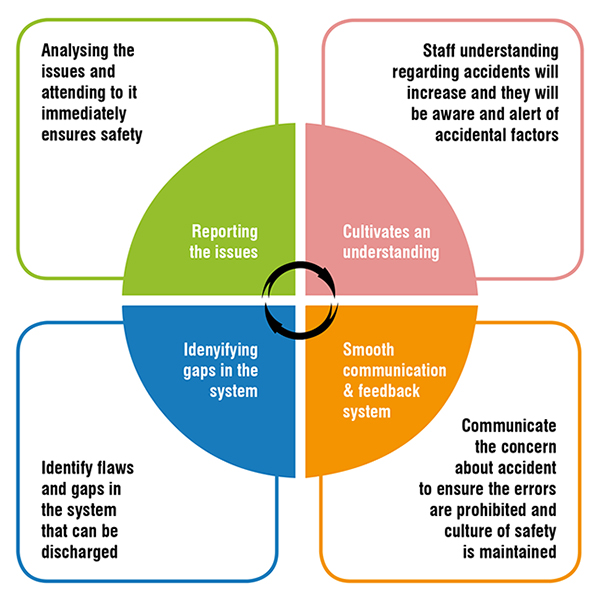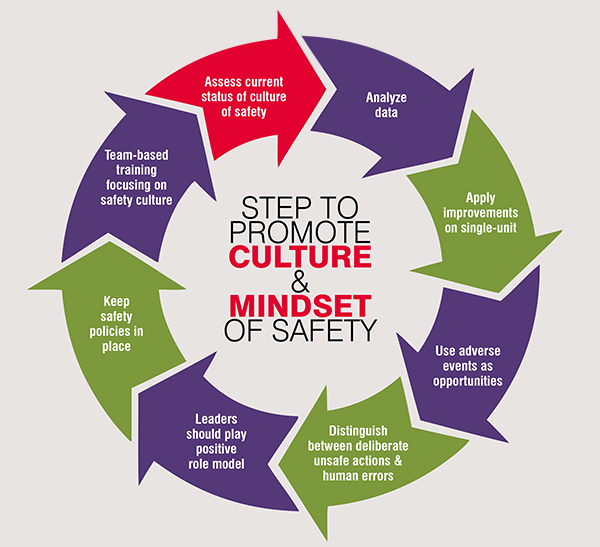High reliable organisations system ensures and manages resilience by focusing on safety of customers over other performances. Their intention is to provide trust worthy services and create environment where by potential problems are foreseen, recognised priory, and basically is always respondent to prevent tragic. Staff should be aware of the culture to be followed with patients and organisation should orient their mindset with help of quality culture programmes and put down model and strategies accordingly in benefit of patient. Often patients are unaware of their rights and care provided, thus empowering them is essential.
Culture of a healthcare organisation impacts the mindset of employees and surrounding environment. Considering organisations culture there are various aspects which should be assessed. It starts from how the staff value the decision of senior, new innovations and technologies that are applied in organisations, risk taking capability, alertness towards minute details, contribution towards needs of the patients apart from treatment, and behaviour in conflict situation. All those things matter and contribute to build a reliable organisation. The most important aspect of quality culture is accountability. Many of them get confused between the two terms responsibility and accountability. In short and sweet words, responsibility tends to share your duty and the credit is shared amongst the team members responsible for that job role. Whereas accountability is a liability which can’t be shared and only you are creditable for it. Accountability is very important in healthcare culture, as it improves doctor-patient trust, reduces the misuse of resources, and helps organisations provide better quality care.

In many healthcare organisations the tendency of measuring the patient safety, is by evaluating the incident reports. The head officers of the healthcare organisations should realise the fact that not all patients and relatives are vocal and have guts to complaint or raise their voice. Instead what they follow is change the center of treatment. This is indeed not right, and leads to increase in cost and declined value of the hospital.
Safety can be distressed in variable ways and system can fail to address and rationalise the process. The logic behind failures may be familiar and predictable, but sometimes the system fails to address and responds inadequately and in unpredictable ways. Some of the safety parameters are achieved by staying alert and acknowledging them at right instant to keep things on track. Normally, in top healthcare organisations, doctors, nurses, and managers follow similar ways to ensure patient safety. These efforts though are not showcased; have to be realised by the assessor person and those minutes things should be acknowledged by the senior team members. This encourages the staff to keep going and motivates to seed the culture of safety parameters. This also concludes that to assess the culture of safety the assessor has to observe beyond the set of metrics and parameters to monitor functioning of the healthcare system.
Right from commencement, organisation should encourage performance measurement involving collecting, reporting and benchmarking data. Assessing scientific as well as operational performance generates buy-in for improvement and allows an organisation to track its improvements over time. This data further can be used to recognise and prioritise goals and to track growth toward establishment of high-reliable organisational goals. While setting the goals several key factors are considered. Before you start, ensure that you understand the systems that are already in place and then plan, execute and maintain services for other safety declined services which are critical in setting goals and achieving error-free performance and operation. The application of soft intelligence skills for monitoring and prospecting the issues receives smaller attention.
The culture of a HRO is such that they encourage the staff and strong safety parameters are followed that permits learning from errors and are observed as opportunities. In any event related to safety, feedback plays a major role. Especially a human or organisational error can be overcome by analysing the communication gaps between the staff and forthcoming by various ways and methods to ensure appropriate feedback system.
“The secret weapon towards building efficient & high-reliable organisation is Quality culture”
HROs often identify strategy through pilot study whereby initially training, planning and practice are carried on small group. The aim is to assimilate three significant practices into the groundwork:
• Commitment entails person to stay motivated and follow work ethics towards their job roles. This provides company modest benefits like developed productivity and lower employee turnover.
• Communication entails person to express straight forwardly and use standardised protocol ways to send and receive data
• Coordination entails person to provide and obtain support for the team effort and under take duties and responsibilities as per team expectations
• Collaboration entails person to believe and admire teammates, monitor awareness at all times, and cooperatively resolve the problems and adopt to conflict management techniques.


The issues arising in healthcare system are perceived as carelessness of some human responsibility but fundamentally entire system is responsible. Single person may be authorised and made accountable for duty but system should be aware that safety of patient is the responsibility of the entire organisation. Staff should realise that major of time is spent at job and independent of job role we should be proactive and do it appropriately as per ethics.
The organisation should follow certain assessment tools as per their services to ensure safety. Assessment is the only way to measure the overall compliance with safety and can highlight the changes, which will engage employees in creating long-term adjustments to your safety culture.
Analysing the assessment parameters will help in pointing out the current status of safety culture. This will guide the way to come up with precise improvements that take your organisations unique characteristics into account.
A pilot study should be carried out on a single department to examine the feasibility of an approach that is proposed to be used in other departments of organisations. Testing on a small-scale provides assurance of long-lasting changes towards building a more positive safety culture.
One of the top ways to promote a patient safety culture is to give doctors and nurses the freedom to openly report any mistakes or problems they notice. Treating every mistake as a learning experience helps keep them from causing harm to patients down the line.
Nowadays in many organisations the issue arises not because of a simple mistake, but because of someone’s flagrant, risky action. Authorised employees should follow certain protocols that will help out to differentiate between these cases and handle the situations accordingly. It’s not about being observed. It’s about what you realise, what you ask, what you say, and what you do.
Executives, managers, and the top head staff should act as the model for all interactions between staff at various levels in a hospital. This helps people feel less over whelmed encountering issues when necessary, and it helps to encourage mutual spirit of respect. Leaders should keenly contribute to all initiatives and programmes designed to improve safety culture. Leaders play an accountable role and are point of source for learning for juniors.
Facility wise safety policies and protocols should be elaborated to each employee and clear plans should be designed for supervising the responsibility and accountability to enhance patient safety. To make reporting process transparent, design definite policies addressing the protocol for reporting adverse events. Assure that all staff is aware of the policies, giving them periodic reminders if necessary.
Organisations having low incidence ratio train their employees to recognise and respond to a variety of problems. Staff is trained in safety applications and education is provided to create awareness and anticipate them to all possible adverse incidents to take right actions. Training for initiatives dedicated to refine quality and safety parameters must include a team-based approach.
Cooperative teamwork surges communication, permits team members to recognise possible errors beforehand, and ensures both patient safety and employee satisfaction.
Adopting approaches to high-reliable strategy must confirm that the strategy is allied to their organisational goals and are way forward to accomplish goals and sustainability toward zero harm. One of the best known strategies is Evidence-Based Leadership (EBL). It helps in designing the framework that ensures building of sustainable culture. That’s because it is based on operating system, accountability parameters that acts as the foundation for orientation and is the critical factor of high-reliable strategy.
Putting together, performing as intended plays a major role in each activity. Safety focus in addition to performance as intended leads to zero harm services. Evidence-based processes plus performance as anticipated results into clinical excellence and last but not the least patient-centric approach and performance as intended leads to positive results for patient engagement. Risk is a function of probability and consequences. By declining the probability of misfortune, high-reliable organisations alter a high-risk initiative to a high-consequence method; they operate to make system ultra-safe.